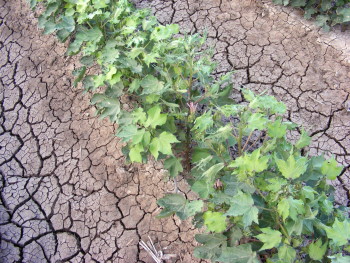
Agricultural News
Producers need to guard against herbicide spray drift
Fri, 08 Apr 2011 3:44:11 CDT
 Herbicide spray drift can be as unhealthy for a producer's wallet as it is for crops susceptible to unintended and unwanted applications.
Herbicide spray drift can be as unhealthy for a producer's wallet as it is for crops susceptible to unintended and unwanted applications.
Joe Armstrong, Oklahoma State University Cooperative Extension weed science specialist, points out that herbicide spray drift can do more than injure susceptible crops and cause prohibited residues in the harvested crops.
"Spray drift also can potentially damage shelterbelts, garden and ornamental plants, cause water pollution and even negatively affect generally non-susceptible crops if they are exposed during a vulnerable growth stage," he said. "Drift also can result in non-uniform application in a field, which may lead to poor weed control and a waste of the producer's time, energy and money invested."
The risk of damage to non-target plants varies considerably among herbicides and among non-target plants.
Gary Strickland, Jackson County Extension director and agricultural educator, cautions that special consideration must be given to cotton in the southwestern area of Oklahoma. (The picture here is of some young cotton hurt by spray drift in southwest Oklahoma)
"For Greer, Harmon and Kiowa counties, application of 2, 4D and dicamba is restricted from May 1 to Oct. 15," he said. "For Jackson and Tillman counties, the restriction applies to those herbicides as well as picloram, triclopyr and clopyralid."
Producers are allowed to use these herbicides during the restricted periods as long as they file a notification of intent with the Oklahoma Department of Agriculture, Food and Forestry.
"Regardless of the producer's county of operation, it's important to remember that the restrictions are in place for a reason," Strickland said. "So take all necessary precautions when using these herbicides, and always follow label directions."
Spray particle size can be increased by reducing spray pressure, increasing nozzle orifice size, special drift reduction nozzles and sprayer cleanout.
Strickland and Armstrong also recommend that producers adjust the boom height of their sprayers. Wind velocity often is greater as the height above ground increases, so spray droplets released from a reduced nozzle height will be affected less by wind velocity.
All herbicides can drift as spray droplets, but some herbicides are sufficiently volatile to cause plant injury from drift of fumes. Vapor drift occurs when a volatile herbicide changes from solid or liquid into a gaseous state and moves from the target area.
"Vapor drift is common with 2, 4D," Armstrong said. "Vapor may drift farther and for a longer time period than spray droplets."
Armstrong reminds producers that herbicides should not be applied when the wind is blowing toward an adjoining susceptible crop or a crop in a vulnerable stage of growth.
"Be aware that crop injury from herbicide drift can even occur with low wind velocities, especially under conditions that result in vertically stable air," he said.
Problems associated with wind are generally obvious. Vertically stable air movement, sometimes referred to as temperature inversion, occurs when air near the soil surface is cooler or similar in temperature to higher air.
"Small spray droplets can be suspended in stable air, move laterally in a light wind and affect plants several miles or more downwind," Armstrong said. "Vertically stable air is most common near sunrise and generally is associated with low wind and clear skies."
Projections for cotton plantings in the United States are expected to increase 15 percent over year-ago levels. Official final statistics often take several years to categorize and publish, but Oklahoma averaged 284,600 bales of cotton produced between 2005 and 2009.
WebReadyTM Powered by WireReady® NSI
Top Agricultural News
More Headlines...



















